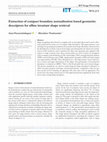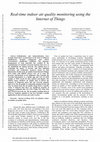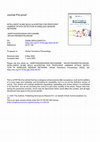Papers by Arjun Paramarthalingam

Inventive Research Organization, 2024
This study presents a comprehensive analysis of company registration trends in India, focusing on... more This study presents a comprehensive analysis of company registration trends in India, focusing on data sourced from the Registrar of Companies (RoC). The study investigates the temporal patterns of company registrations, emphasizing principal business activities and classifications into public and private sectors. Leveraging advanced data pre-processing techniques, The Study explores the spatial and temporal dynamics of company registrations. Furthermore, a suite of machine learning algorithms, including Linear regression, Decision tree, Random Forest, GBM, SVM, KNN, Naive Bayes, and Weka, is employed to predict future registration trends. Visualization of insights is facilitated through the use of Tableau. The findings provide valuable insights for stakeholders in business, policy, and investment sectors, aiding informed decision-making and strategic planning.

2021 International Conference on System, Computation, Automation and Networking (ICSCAN), Jul 30, 2021
Virtual mind inquiries about hastening the improvement of reasonable incessant Brain Computer Int... more Virtual mind inquiries about hastening the improvement of reasonable incessant Brain Computer Interface (BCI). Equipment developments the expansion ability of Virtual mind dissect and Brain PC-wearable sensors have made possible a few novel programming systems for engineers to use and make applications joining BCI and IoT(Internet of Things). At present, a comprehensive study on BCI in IoT from dissimilar viewpoints; together with Electroencephalogram (EEG) based BCI models, and current dynamic stages. In view of this analyses, the fundamental discoveries of study eye on three substantial improvement patterns of BCI, which are EEG, IoT, and cloud computing. Utilizing this it is totally helpful for finding the genuine condition regardless of whether the cerebrum is alive or dead. In the incident that it is active, at that point the movement of the mind is checked and put away. Through this anybody can arrive at resolution that whether the activity done is legitimate or illegal. This has a favorable position for two situations. First is for Adulteration in bank subtleties and secondly fabrication in resource archives. The principle point is to transfer human cerebrum private things in the cloud, if there are any adjustments in the status of the mind, the virtual cerebrum site will go about as the human mind.

Journal of Trends in Computer Science and Smart Technology, Jul 13, 2022
Current trending- Internet of things (IoT) is internetworking of an assortment of hardware device... more Current trending- Internet of things (IoT) is internetworking of an assortment of hardware devices to offer a collection of applications and services. In the present-day world, ransomware cyber-attack has become one of the major attacks in IoT systems. Ransomware is a hazardous malware that targets the user’s computer inaccessible or inoperative, and then requesting the computer victim user to transfer a huge ransom to relapse the damage. At instance, the evolution rate outcomes illustrate that the level of attacks such as Locky and Cryptowall ransomware are conspicuously growing then other ransomware. Thus, these ransomware relations are the latent threat to IoT. To address the issue, this paper presents Two-phase ransomware prediction model based on the behavioral and communication study of Cryptowall ransomware for IoT networks. This proposed Two-phase model equipped with, Phase-1: observes the inward TCP/IP flowing traffic through a monitoring server to avert the ransomware attack The procedure of the monitoring server is to monitor the IoT's TCP/IP. The process of Monitoring TCP/IP is to extract TCP/IP header and routines command and control (C&C) server IP blacklisting to discover the ransomware attacks. In Phase-2: the proposed system will also analyze the application pattern for malicious behavior of the Web and URLs. Several societies have very affluent security tools in their milieu, but their events or logs are not monitored, which make affluent tools ineffective. The process of having efficient security based monitoring server is vital for detecting and controlling the ransomware attack.

Iet Image Processing, Dec 26, 2020
Shape recognition and retrieval is a complex task on non-rigid objects and it can be effectively ... more Shape recognition and retrieval is a complex task on non-rigid objects and it can be effectively performed by using a set of compact shape descriptors. This paper presents a new technique for generating normalised contour points from shape silhouettes, which involves the identification of object contour from images and subsequently the object area normalisation (OAN) method is used to partition the object into equal part area segments with respect to shape centroid. Later, these contour points are used to derive six descriptors such as compact centroid distance (CCD), central angle (ANG), normalized points distance (NPD), centroid distance ratio (CDR), angular pattern descriptor (APD) and multi-triangle area representation (MTAR). These descriptors are a 1D shape feature vector which preserve contour and region information of the shapes. The performance of the proposed descriptors is evaluated on MPEG-7 Part-A, Part-B and multi-view curve dataset images. The present experiments are aimed to check proposed shape descriptor's robustness to affine invariance property and image retrieval performance. Comparative study has also been carried out for evaluating our approach with other state of the art approaches. The results show that image retrieval rate in OAN approach performs significantly better than that in other existing shape descriptors.
2023 International Conference on Disruptive Technologies (ICDT)

Image memorability is a very hard problem in Image Processing due to its subjective nature. But d... more Image memorability is a very hard problem in Image Processing due to its subjective nature. But due to the introduction of Deep Learning and the large availability of data and GPUs, great strides have been made in predicting the memorability of an image. In this paper, we propose a novel deep learning architecture called ResMem-Net that is a hybrid of LSTM and CNN that uses information from the hidden layers of the CNN to compute the memorability score of an image. The intermediate layers are important for predicting the output because they contain information about the intrinsic properties of the image. The proposed architecture automatically learns visual emotions and saliency, shown by the heatmaps generated using the GradRAM technique. We have also used the heatmaps and results to analyze and answer one of the most important questions in image memorability: "What makes an image memorable?". The model is trained and evaluated using the publicly available Large-scale Image Memorability dataset (LaMem) from MIT. The results show that the model achieves a rank correlation of 0.679 and a mean squared error of 0.011, which is better than the current state-of-the-art models and is close to human consistency (p=0.68). The proposed architecture also has a significantly low number of parameters compared to the state-of-the-art architecture, making it memory efficient and suitable for production.

2022 Third International Conference on Intelligent Computing Instrumentation and Control Technologies (ICICICT)
Globalization and industrialization have brought about their reverberation in the form of differe... more Globalization and industrialization have brought about their reverberation in the form of different simultaneous harmful components that affects environment's equilibrium conditions. The improper management of such materials has resulted in the contamination of essential ecosystem elements that serve as the foundation for human survival. The solution here is evaluating the degree of ferocity and then initiating preventive and eradication measures based on that information. In this work, air quality-based internet of things (IoT) nodes with MQ135 sensors were set to sense the presence and intensity of air pollutants, then transmit the recorded information to a mobile app and web via GSM module or WiFi system for data analysis and display. The MQ135 sensor monitors air quality since it detects the majority of dangerous gases and can correctly quantify their level. The air quality is consistently monitored and will raise an alarm when the air quality drops below a specific range, it indicates that there are significant amounts of dangerous pollutants like CO, CO2, C 2 H 4 , NO, NO 2, SO 2 and CH 4 present in the air. The air quality readings taken in PPM are regularly updated to the user through a mobile application to take necessary preventive action.

Global Transitions Proceedings, 2022
Wireless Sensor Networks (WSNs) depicts to the group of spatially distributed sensor nodes, each ... more Wireless Sensor Networks (WSNs) depicts to the group of spatially distributed sensor nodes, each node is having individual battery for power consumption which senses the factors like Temperature, Pressure, Soil makeup, Vehicular movement, and checks the physical presence of objects, which are communicate through internet and passing messages between nearest neighbor nodes. WSN are extensively used in several applications like Environmental Monitoring, Area Monitoring, Engineering Monitoring, Health Care Monitoring, and Military Applications. Since WSN are highly susceptible for many attacks especially Jamming Attack. This causes high energy consumption, reduces the life time of nodes, affects the entire sensor networks and most significantly also the confidentiality and integrity of the data packets which are transmitted through dissimilar nodes in the network. In order to overcome these issues, a new bio-inspired algorithm called Intelligent Slime Mold (ISM) has been introduced for detection jamming node and to setting up of alternate optimal path form source node to destination node in WSN to avoid jammer affected nodes by applying Context Aware Decision Rule (CADR). This work ensures the confidentiality and integrity of both the network and data packets.

Journal of Trends in Computer Science and Smart Technology
Current trending- Internet of things (IoT) is internetworking of an assortment of hardware device... more Current trending- Internet of things (IoT) is internetworking of an assortment of hardware devices to offer a collection of applications and services. In the present-day world, ransomware cyber-attack has become one of the major attacks in IoT systems. Ransomware is a hazardous malware that targets the user’s computer inaccessible or inoperative, and then requesting the computer victim user to transfer a huge ransom to relapse the damage. At instance, the evolution rate outcomes illustrate that the level of attacks such as Locky and Cryptowall ransomware are conspicuously growing then other ransomware. Thus, these ransomware relations are the latent threat to IoT. To address the issue, this paper presents Two-phase ransomware prediction model based on the behavioral and communication study of Cryptowall ransomware for IoT networks. This proposed Two-phase model equipped with, Phase-1: observes the inward TCP/IP flowing traffic through a monitoring server to avert the ransomware atta...
Advancement in digital technologies have resulted in large amount of images. Hence there a huge d... more Advancement in digital technologies have resulted in large amount of images. Hence there a huge demand in retrieving desired images. In order to retrieve an image, the image has to be described or represented by certain features. Shape is an important visual feature of an image. Searching for images using shape features has been an important field of study. There are many shape representation and description techniques in the literature. In this paper, we review one of the important shape descriptor techniques named curvature scale space. The CSS extracts the shape feature of the image and represents them as curvature maxima points. We discuss implementation procedure of this technique, its variants and discuss their advantages and disadvantages.
Rev. Téc. Ing. Univ. Zulia., 2016

Lecture Notes in Electrical Engineering, 2014
Shape features play vital role in computer vision applications. The object silhouettes provide mo... more Shape features play vital role in computer vision applications. The object silhouettes provide more evident properties for shape matching, and analysis. This paper presents contour and region based affine invariant shape descriptor based on object area normalization. The continuous contour is normalized by dividing total object area into equal part areas using sector area approach. This forms the 1-D feature vector to represent image object characteristics. The correlation coefficient and Euclidean distance are the metrics used for similarity measurement. The proposed method is validated on MPEG-7 CE Shape-1 Part-B dataset images and its affine variants. From the experimental results, it is observed that normalization based on area of the sector is more accurate in representing contour and region information than triangle area method. Moreover, this work can be adapted in object recognition and image retrieval tasks.
Applied Mathematical Sciences, 2015
Simple and fast feature extraction methods are in need today for Content Based Image Retrieval (C... more Simple and fast feature extraction methods are in need today for Content Based Image Retrieval (CBIR) and object recognition applications. The work presented in this paper is contour based one dimensional shape feature extraction technique for closed contour objects. The continuous contour is normalized into 'N' representative points. The sector area based object area normalization (OAN) technique is used for contour normalization. The centroid distance from all normalized points forms 1-D Compact Centroid Distance (CCD) feature vector. The experiments are conducted in MPEG-7 CE Shape-1 Part-B dataset images to test affine invariance property and image retrieval accuracy. Experimental results show the effectiveness of the proposed method in content-based image retrieval tasks.
IFIP Advances in Information and Communication Technology
2021 International Conference on System, Computation, Automation and Networking (ICSCAN)

IET Image Processing, 2021
Shape recognition and retrieval is a complex task on non-rigid objects and it can be effectively ... more Shape recognition and retrieval is a complex task on non-rigid objects and it can be effectively performed by using a set of compact shape descriptors. This paper presents a new technique for generating normalised contour points from shape silhouettes, which involves the identification of object contour from images and subsequently the object area normal-isation (OAN) method is used to partition the object into equal part area segments with respect to shape centroid. Later, these contour points are used to derive six descriptors such as compact centroid distance (CCD), central angle (ANG), normalized points distance (NPD), centroid distance ratio (CDR), angular pattern descriptor (APD) and multi-triangle area representation (MTAR). These descriptors are a 1D shape feature vector which preserve contour and region information of the shapes. The performance of the proposed descriptors is evaluated on MPEG-7 Part-A, Part-B and multi-view curve dataset images. The present experiments are aimed to check proposed shape descriptor's robustness to affine invariance property and image retrieval performance. Comparative study has also been carried out for evaluating our approach with other state of the art approaches. The results show that image retrieval rate in OAN approach performs significantly better than that in other existing shape descriptors.
Applied Mathematical Sciences, 2015
Simple and fast feature extraction methods are in need today for Content Based Image Retrieval (C... more Simple and fast feature extraction methods are in need today for Content Based Image Retrieval (CBIR) and object recognition applications. The work presented in this paper is contour based one dimensional shape feature extraction technique for closed contour objects. The continuous contour is normalized into 'N' representative points. The sector area based object area normalization (OAN) technique is used for contour normalization. The centroid distance from all normalized points forms 1-D Compact Centroid Distance (CCD) feature vector. The experiments are conducted in MPEG-7 CE Shape-1 Part-B dataset images to test affine invariance property and image retrieval accuracy. Experimental results show the effectiveness of the proposed method in content-based image retrieval tasks.
International Journal of Innovative Research in Computer and Communication Engineering, 2014
Advancement in digital technologies have resulted in large amount of images. Hence there a huge d... more Advancement in digital technologies have resulted in large amount of images. Hence there a huge demand in retrieving desired images. In order to retrieve an image, the image has to be described or represented by certain features. Shape is an important visual feature of an image. Searching for images using shape features has been an important field of study. There are many shape representation and description techniques in the literature. In this paper, we review one of the important shape descriptor techniques named curvature scale space. The CSS extracts the shape feature of the image and represents them as curvature maxima points. We discuss implementation procedure of this technique, its variants and discuss their advantages and disadvantages.

Lecture Notes in Electrical Engineering, vol 326. Springer, New Delhi, 2015
Shape features play vital role in computer vision applications. The object silhouettes provide mo... more Shape features play vital role in computer vision applications. The object silhouettes provide more evident properties for shape matching, and analysis. This paper presents contour and region based affine invariant shape descriptor based on object area normalization. The continuous contour is normalized by dividing total object area into equal part areas using sector area approach. This forms the 1-D feature vector to represent image object characteristics. The correlation coefficient and Euclidean distance are the metrics used for similarity measurement. The proposed method is validated on MPEG-7 CE Shape-1 Part-B dataset images and its affine variants. From the experimental results, it is observed that normalization based on area of the sector is more accurate in representing contour and region information than triangle area method. Moreover, this work can be adapted in object recognition and image retrieval tasks.

Uploads
Papers by Arjun Paramarthalingam